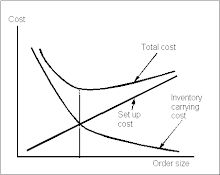Amidst the growing economic concerns that our country is facing, many businesses, both large and small, are experiencing significant changes to their cost structure(s). This article does a good job of highlighting the broad-spanning increase in commodities costs, which are causing havoc for many organizations.
We can relate this article to our EOQ discussions from class (Pause briefly for an outburst of pure excitement!!!)
The fundamental objective for our EOQ models is to minimize total costs, which is primarily a function of ordering and holding costs. As a result of violent fluctuations in the costs of various commodities, there has been an abrupt shift in firms' ordering and holding costs, which effectively changes an organization's EOQ calculations. For example, the increasing price of gasoline has made transportation more expensive; thus, these increasing transportation costs have changed relevant ordering costs for many products.
-Andrew Freeman
Subscribe to:
Post Comments (Atom)

3 comments:
Here is the article's hyperlink:
http://online.wsj.com/article/SB122394474195131187.html
It is very good that you bring this to our attention and you share the link with us.
Good job Andrew!
I feel that it is important that we must constantly look at the EOQ and make sure that we are ordering the optimal level as to minimize costs. The reason behind this is that the inputs into the EOQ formula can change on a regular basis. We have also learned that we need to look at other factors that may cause it to be more cost effective to order more that what the EOQ suggests. I will not mention these situations since we have already gone over them in class.
Post a Comment